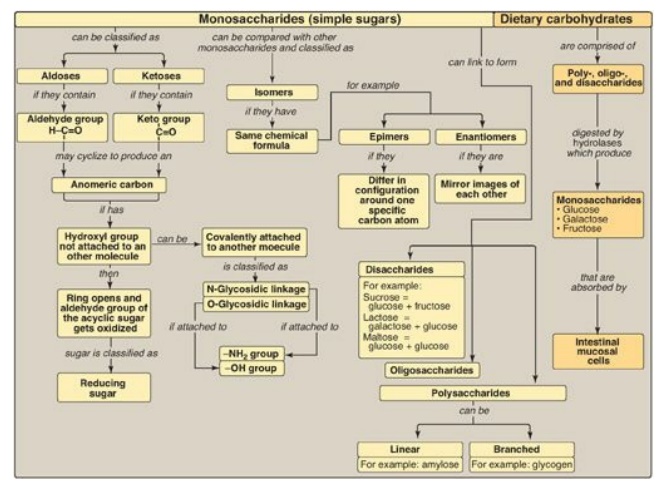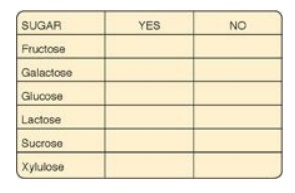Chapter Summary, Study Question
| Home | | Biochemistry |Chapter: Biochemistry : Introduction to Carbohydrates
Monosaccharides containing an aldehyde group are called aldoses, and those with a keto group are called ketoses.
CHAPTER SUMMARY
Monosaccharides (Figure
7.12 ) containing an aldehyde group are called aldoses, and those with a keto
group are called ketoses. Disaccharides, oligosaccharides, and polysaccharides
consist of monosaccharides linked by glycosidic bonds. Compounds with the same
chemical formula but different structures are called isomers. If two
monosaccharide isomers differ in configuration around one specific carbon atom
(with the exception of the carbonyl carbon), they are defined as epimers of
each other. If a pair of sugars are mirror images (enantiomers), the two
members of the pair are designated as D- and L-sugars. If the aldehyde group on
an acyclic sugar gets oxidized as a chromogenic agent gets reduced, that sugar
is a reducing sugar. When a sugar cyclizes, an anomeric carbon is created from
the aldehyde group of an aldose or keto group of a ketose. The sugar can have
two configurations, α or β. A sugar with its anomeric carbon linked to another
structure forms a glycoside. Sugars can be attached either to an – NH2
or an –OH group, producing N- and O-glycosides. Salivary α-amylase acts o n
dietary polysaccharides (starch, glycogen), producing oligosaccharides.
Pancreatic α-amylase continues the process of carbohydrate digestion. The final
digestive processes occur at the mucosal lining of the small intestine. Several
disaccharidases (for example, lactase [β-galactosidase] , sucrase, isomaltase,
and maltase) produce monosaccharides (glucose, galactose, and fructose). These
enzymes are transmembrane proteins of the luminal brush border of intestinal
mucosal cells. Absorption of the monosaccharides requires specific
transporters. If carbohydrate degradation is deficient (as a result of
heredity, disease, or drugs that injure the intestinal mucosa), undigested
carbohydrate will pass into the large intestine, where it can cause osmotic
diarrhea. Bacterial fermentation of the material produces large volumes of CO2
and H2, causing abdominal cramps, diarrhea, and flatulence. Lactose
intolerance, dependent loss of lactase (adult hypolactasia), these
deficiencies.

Figure 7.12 Key concept map for the classification and structure of monosaccharides and the digestion of dietary carbohydrates.
Study Question
Choose the ONE best answer.
7.1 Which of the following statements best
describes glucose?
A. It is a C-4 epimer of galactose.
B. It is a ketose and
usually exists as a furanose ring in solution.
C. It is produced from
dietary starch by the action of α-amylase.
D. It is utilized in
biological systems only in the L-isomeric form.
Correct answer = A. Glucose and galactose differ only
in configuration around carbon 4 and so are C-4 epimers that are interconvertible
by the action of an epimerase. Glucose is an aldose sugar that typically exists
as a pyranose ring in solution. Fructose, however, is a ketose with a furanose
ring. α-Amylase does not produce monosaccharides. The D-isomeric form of
carbohydrates is most typically the form found in biologic systems, in contrast
to amino acids.
7.2 A young man entered his physician’s office
complaining of bloating and diarrhea. His eyes were sunken, and the physician
noted additional signs of dehydration. The patient’s temperature was normal. He
explained that the episode had occurred following a birthday party at which he
had participated in an ice cream–eating contest. The patient reported prior
episodes of a similar nature following ingestion of a significant amount of
dairy products. This clinical picture is most probably due to a deficiency in
the activity of:
A. isomaltase.
B. lactase.
C. pancreatic
α-amylase.
D. salivary α-amylase.
E. sucrase.
Correct answer = B. The physical symptoms suggest a
deficiency in an enzyme responsible for carbohydrate degradation. The symptoms
observed following the ingestion of dairy products suggest that the patient is
deficient in lactase.
7.3 Routine examination of the urine of an
asymptomatic pediatric patient showed a positive reaction with Clinitest (a
copper reduction method of detecting reducing sugars) but a negative reaction
with the glucose oxidase test for detecting glucose.
Using these data, show on the chart below which of
the sugars could (YES) or could not (NO) be present in the urine of this
individual.

Each of the listed
sugars, except for sucrose and glucose, could be present in the urine of this
individual. Clinitest is a nonspecific test that produces a change in color if
urine is positive for reducing substances such as reducing sugars (fructose,
galactose, glucose, lactose, xylulose). Because sucrose is not a reducing
sugar, it is not detected by Clinitest. The glucose oxidase test will detect
only glucose, and it cannot detect other sugars. The negative glucose oxidase
test in the face of a positive reducing sugar test means that glucose cannot be
the reducing sugar in the patient’s urine.
7.4 Why are α-glucosidase inhibitors that are taken
with meals, such as acarbose and miglitol, used in the treatment of diabetes?
What effect should these drugs have on the digestion of lactose?
α-Glucosidase
inhibitors slow the production of glucose from dietary carbohydrates, thereby
reducing the postprandial rise in blood glucose and facilitating better blood
glucose control in diabetics. These drugs have no effect on lactose digestion
because the disaccharide lactose contains a β-glycosidic bond, not an
α-glycosidic bond.
Related Topics
